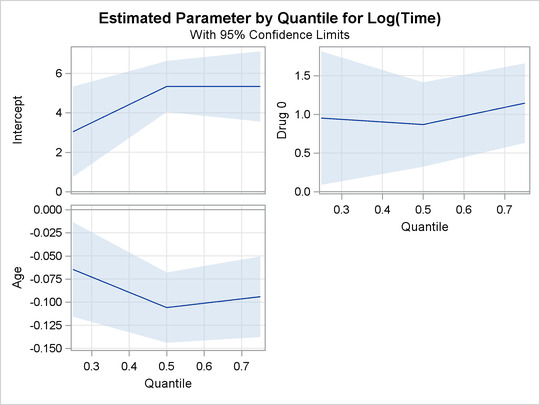The QUANTLIFE Procedure
Getting Started: QUANTLIFE Procedure
This example uses the human immunodeficiency virus (HIV) study data from Hosmer and Lemeshow (1999) to illustrate the basic features of PROC QUANTLIFE.
In this study, subjects were followed after a confirmed diagnosis of HIV. The primary goal was to evaluate the effect of various factors on the survival time. Two covariates for each subject were collected: age and history of prior intravenous drug use.
The following DATA step creates the data set HIV, which contains the variable Time (the follow-up time in days), the variable Status (with value 0 if Time was censored and 1 otherwise), the variable Drug (with value 1 for prior intravenous drug use and 0 otherwise), and the variable Age (the patient’s age in years at the beginning of the follow-up).
data HIV;
input Time Age Drug Status;
datalines;
5 46 0 1
6 35 1 0
8 30 1 1
3 30 1 1
22 36 0 1
1 32 1 0
... more lines ...
1 34 1 1
;
You can use PROC QUANTLIFE to explore the relationship between the survival time and the two covariates at different quantiles.
Suppose you are interested in the median survivors and in the longer and shorter survivors. The following statements fit a linear model for the 25th, 50th, and 75th percentiles:
ods graphics on; proc quantlife data=hiv log plots=quantplot seed=1268; class Drug; model Time*Status(0) = Drug Age / quantile=(0.25 0.5 0.75); Drug_Effect: test Drug; run;
The LOG option fits a quantile regression model for the log of Time, as is done by an accelerated failure time (AFT) model in standard survival analysis. The SEED= option maintains reproducibility
of the resampling method that is used for statistical inference.
The MODEL statement specifies the response variable, Time, and the censoring variable, Censor. The value that indicates censoring is enclosed in parentheses. The values of Time are considered to be censored if the value of Censor is 0; otherwise, they are considered to be event times. The QUANTILE= option requests a fit of the conditional quantile function
 at the quantile levels 0.25, 0.5, and 0.75.
at the quantile levels 0.25, 0.5, and 0.75.
The TEST statement requests a test for the hypothesis that there is no drug effect at each of the quantile levels.
Figure 94.1 displays basic model information. For example, you can see from Figure 94.1 that the response is log(Time) and the censoring rate is 20%.
Figure 94.1: Model Fitting Information
Figure 94.2 displays the parameter estimates, which are computed using the default Kaplan-Meier-type estimator. For more information,
see the section Kaplan-Meier-Type Estimator for Censored Quantile Regression. In addition, Figure 94.2 displays standard errors, 95 confidence limits, t values, and p-values that are computed by the default resampling method, exponentially weighted resampling. For more information, see the
section Exponentially Weighted Method.
confidence limits, t values, and p-values that are computed by the default resampling method, exponentially weighted resampling. For more information, see the
section Exponentially Weighted Method.
A different quantile regression model is fitted for each quantile, and the first column (Quantile) in Figure 94.2 identifies the model for the parameter estimates. Age has a negative effect on survival time. You can use the parameter estimates to predict the survival time at the quantiles of interests. For example, the 75th percentile survival time for a person who has no previous intravenous drug use at age 46 is
![\[ \exp (5.3351 +1.1451 -0.0941\times 46)=8.6 \mbox{ years} \]](images/statug_quantlife0022.png)
Figure 94.2: Parameter Estimates
| Parameter Estimates | |||||||||
|---|---|---|---|---|---|---|---|---|---|
| Quantile | Parameter | DF | Estimate | Standard Error |
95% Confidence Limits | t Value | Pr > |t| | ||
| 0.2500 | Intercept | 1 | 3.0373 | 1.1680 | 0.7482 | 5.3265 | 2.60 | 0.0108 | |
| Drug | 0 | 1 | 0.9516 | 0.4403 | 0.0887 | 1.8146 | 2.16 | 0.0331 | |
| Drug | 1 | 0 | 0 | 0 | 0 | 0 | . | . | |
| Age | 1 | -0.0646 | 0.0261 | -0.1158 | -0.0135 | -2.48 | 0.0150 | ||
| 0.5000 | Intercept | 1 | 5.3351 | 0.6605 | 4.0406 | 6.6296 | 8.08 | <.0001 | |
| Drug | 0 | 1 | 0.8681 | 0.2786 | 0.3219 | 1.4142 | 3.12 | 0.0024 | |
| Drug | 1 | 0 | 0 | 0 | 0 | 0 | . | . | |
| Age | 1 | -0.1059 | 0.0194 | -0.1439 | -0.0679 | -5.46 | <.0001 | ||
| 0.7500 | Intercept | 1 | 5.3351 | 0.9091 | 3.5532 | 7.1170 | 5.87 | <.0001 | |
| Drug | 0 | 1 | 1.1451 | 0.2625 | 0.6307 | 1.6596 | 4.36 | <.0001 | |
| Drug | 1 | 0 | 0 | 0 | 0 | 0 | . | . | |
| Age | 1 | -0.0941 | 0.0223 | -0.1378 | -0.0505 | -4.23 | <.0001 | ||
The PLOTS=QUANTPLOT option in the PROC QUANTLIFE statement requests the quantile process plots, which are shown in Figure 94.3. The quantile process plot is a scatter plot of an estimated regression parameter against the quantile level. You can use these plots to compare quantile-specific covariate effects. A curve that is not constant can indicate heterogeneity in the data. For example, Figure 94.3 shows that the drug effect does not change much across quantiles.
Figure 94.3: Estimated Parameters

The tests that are requested by the TEST statement are shown in Figure 94.4.
Figure 94.4: Tests of Significance
The tests indicate that the coefficient of Drug is significantly different from 0 at the 25th, 50th, and 75th percentiles.
